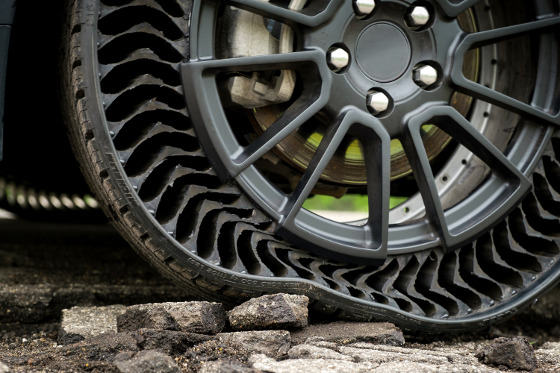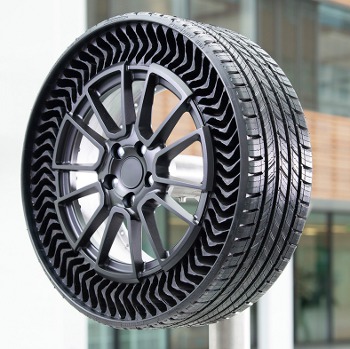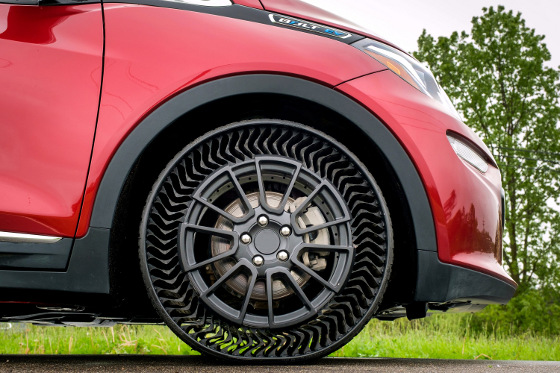 |
| September 24, 2019 | Volume 15 Issue 36 |
Designfax weekly eMagazine
Archives
Partners
Manufacturing Center
Product Spotlight
Modern Applications News
Metalworking Ideas For
Today's Job Shops
Tooling and Production
Strategies for large
metalworking plants
Michelin and GM roll forward with airless tire design

Michelin and General Motors presented a new generation of airless wheel technology for passenger vehicles, the Michelin Uptis Prototype (or Unique Punctureproof Tire System), at the Movin'On Summit for sustainable mobility in Montreal this past June. The partnership also announced a joint research agreement to validate the airless prototype, with the goal of putting Uptis on passenger models as early as 2024.

Uptis features marked improvements over previous airless tire designs in architecture and composite materials, which enable the prototype to bear the car's weight at road-going speeds.
These innovations combine to eliminate compressed air to support the vehicle's load and result in big environmental savings, because approximately 200 million tires worldwide are scrapped prematurely every year as a result of punctures, damage from road hazards, or improper air pressure that causes uneven wear.
The Uptis Prototype is derived from the Michelin Tweel technologies and shares some design concepts in common: a tire-wheel assembly, "spokes" that carry the load, and a shear beam outer ring, among others. Tweel was introduced in 2004, and industrial production started a few years later. [See "It's TWEELy happening: Michelin opens world's first manufacturing plant to build airless radial tires," a 2014 update in Designfax.]
Although Uptis outwardly resembles Tweel, its structure and materials represent a technological advancement. These innovations replicate the functions of a traditional tire, without the inflation pressure required to achieve the target performances. The Uptis Prototype is re-engineered for handling and maneuvering at highway speeds, whereas current Tweel applications can bear a traditional car's weight but handle well only at much slower speeds. Simply put, Uptis is tuned for the requirements of passenger vehicles; Tweel is not. Tweel seems better suited for slow-moving construction or off-road vehicles.
Because Uptis is airless, the innovative wheel assembly eliminates the dangerous risk of flat tires and blowouts. Benefits include:
- Drivers of passenger vehicles may feel safer on the road.
- Operators of passenger vehicle fleets minimize downtime and improve efficiency resulting from flat tires and near-zero levels of maintenance.
- Society at large benefits from environmental savings through reduced use of raw materials for replacement tire or spare tire production.
The Uptis Prototype represents a major advancement toward achieving Michelin's VISION concept, which was first presented at the Movin'On Summit in 2017 as an illustration of the company's strategy for research and development in sustainable mobility. The VISION concept introduced four main pillars of innovation: airless, connected, 3D-printed, and 100 percent sustainable (entirely renewable or bio-sourced materials).
Michelin says the Uptis Prototype is "re-engineered for today's passenger vehicles, and it is also well suited to emerging forms of mobility." The company also says the vehicles and fleets of tomorrow, whether they are autonomous, all-electric, shared service, or other applications, will require near-zero maintenance from tires to maximize their operating capabilities.
Michelin says it has achieved a 10-year-plus advantage in its abilities to manufacture these technologies at scale for mainstream passenger-vehicle applications.

Michelin and GM began testing the Uptis Prototype this summer on a fleet of Chevrolet Bolt EV vehicles in Milford, MI. No decision has been made at this stage for other vehicles.
But will drivers notice the difference between Uptis and a standard tire? According to Michelin, it's not likely. The company claims Uptis improves the vehicle's performance without compromising comfort in any way. The developers liken the physical performance to a zero-pressure tire. Michelin says a standard pneumatic tire and wheel typically weighs nearly 46 lb (21 kg), while a mounted zero-pressure ("run flat") mounted tire can weigh up to 51 lb (23 kg). The Uptis Prototype assembly's current design weighs about 50 lb (22.5 kg).
Uptis can also yield overall vehicle weight reductions by removing the need for a spare tire, jack, or tire-pressure monitoring systems that exist in most vehicles today.
A target market for Uptis is fleet applications, especially autonomous passenger fleets or urban fleets that transport high passenger volumes. Although Uptis may prove an ideal solution for these new forms of mobility, its range of possibilities is broader, including immediate improvements in safety and efficiency for global markets where flats occur at higher rates.
Neither company gave details on performance testing so far in varied or specific weather environments -- especially snow and rain. What happens when snow or mud gets in those little side vents in the tires? Likewise, no measurements were given on key performance parameters such as tire rolling resistance.
But will Uptis really be a success? Stay tuned. We will have to wait and see how it rolls for real.
Sources: Michelin, GM
Published September 2019
Rate this article
View our terms of use and privacy policy
